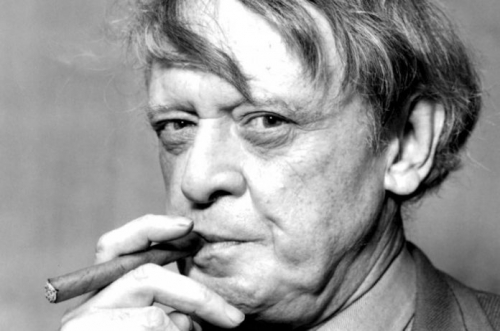mercredi, 19 juin 2019
Anthony Burgess and Modernism

Anthony Burgess and Modernism
Graham Foster
Ex: https://www.anthonyburgess.org
Anthony Burgess came of age as modernism was at its peak, and the movement influenced much of his writing. As a reaction against the realism of the late nineteenth century, modernist works of literature aimed to disrupt many of the established tenets of novel-writing and poetry. In novels, the omniscient narrators, the linear structures and the focus on external description of environments and characters were replaced with subjectivity, fractured plotlines and a focus on the internal thoughts of characters (the latter inspired by the rise in psychoanalysis of the early twentieth century). Modernist poets rejected the devices of the Romantic period, preferring to experiment with form, allusion and the patchwork technique of using many fragmented languages and registers. The whole modernist project could be summed up with Ezra Pound’s phrase ‘make it new’.
Burgess’s first introduction to a modernist text was his reading of James Joyce’s A Portrait of the Artist as a Young Man at the age of fourteen. He describes the most modernist section of the novel, the hellfire sermon, as fear-inducing, so important in his mind that it drove him back to the church for another try at Catholicism. It was in the early 1930s, still a student at school when he first encountered Joyce’s Ulysses, a moment he describes in conflicting terms. While Ulysses was a constant presence throughout his career, and his first novels attempted to superimpose a contemporary story onto a mythological framework (see A Vision of Battlements’ treatment of the Aeneid and The Worm and the Ring’s retelling of the Niebelungenlied, for example), he writes that the post-Ulysses novelist ‘is forced to pretend Ulysses does not exist’, and that Joyce’s achievements made him cautious about writing his own fiction.
Yet what Burgess takes from Joyce is the elevating of language above almost everything else. He writes, ‘If Joyce taught nothing else he certainly taught a rigorous attention to language – an aspect of the traditional British novel which is generally despised’. Throughout all of his fiction, Burgess experiments with language, sometimes in overt ways as in A Clockwork Orange and Nothing Like the Sun, and sometimes in more subtle ways in novels such as the Enderby books and One Hand Clapping.
Despite his early connection to Joyce, it was T.S. Eliot who galvanised Burgess’s artistic interest in modernism. He first read Eliot when he borrowed The Waste Land from the public library in Manchester when he was fifteen. For the young Burgess, this was a gateway to Dante and Baudelaire, and he strove to memorise the poem in its entirety. Some years later, on a trip to London in 1936, he bought Eliot’s Collected Poems: 1909-1935 at a bookshop on Charing Cross Road. He began reading the poems on the train back to Manchester, and was so taken with Eliot’s work, he began a musical setting of the songs in Sweeney Agonistes. The impact of Eliot’s work on Burgess is hard to gauge, though Burgess goes some way to explain the influence: ‘the tastes of most of us have been Eliotian for the past forty-five years. He was a maker in a double sense: he made not only his poetry but also the minds that read it […] To reject Eliot was to welcome anarchy.’
Burgess’s analysis of Eliot’s influence recalls his writing about Ezra Pound. He describes Pound’s Cantos and his Homage to Sextus Propertius as ‘immensely important, supreme examples of the development of an idiolect, a personal language, which became the language of a whole generation.’
It was with the voices of Joyce, Pound and Eliot in his head that Burgess began writing fiction and his experiments with form, narrative and language owe these writers a large debt. Burgess’s most clear experiment in modernist expression came in 1974 when he published Napoleon Symphony. As with Joyce’s work (and indeed his own early work), the novel rests on a mythic framework. Burgess maps the biography of Napoleon onto the myth of Prometheus, but in another layer of complexity, he also frames the narrative around Beethoven’s Eroica symphony (itself based on the Prometheus myth). The story is told in the high modernist style, linguistically complex and fragmented.
Throughout Burgess’s career as a writer his experiments in fiction have been heavily influenced by modernism, yet he also experimented with postmodern form, in particular in the playful MF, based on the post-structuralist theories of Claude Levi-Strauss. This makes it hard to categorise Burgess, though perhaps the best depiction of the push and pull the various literary movements of the twentieth century had on his work is in Earthly Powers. As his protagonist Kenneth Toomey arrives at his eighty-first birthday he has experienced the blossoming of the modernist movement and the explosion of postmodern culture. He is the ultimate twentieth century writer, and perhaps Burgess is thinking of his own creative maturation through the different movements of the century.
Graham Foster
Visit our exhibition ‘Anthony Burgess and Modernism’ exploring all of these themes in more depth at the Burgess Foundation, 17 June to 30 September 2019. Free and open weekdays 10am to 3pm, and in the evenings for events. Anthony Burgess’s books Here Comes Everybody: An Introduction to James Joyce for the Ordinary Reader and Flame Into Being: the Life of D.H. Lawrence are republished this month by Galileo. Click here for more.
11:50 Publié dans Littérature | Lien permanent | Commentaires (0) | Tags : modernisme, anthony burgess, littérature, lettres, lettres anglaises, littérature anglaise, avant-gardes |  |
|  del.icio.us |
del.icio.us |  |
|  Digg |
Digg | ![]() Facebook
Facebook



Les commentaires sont fermés.